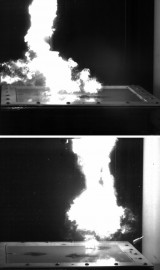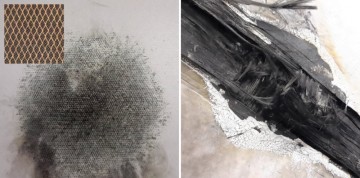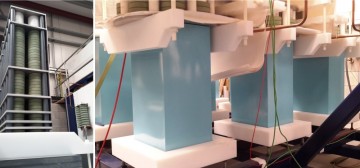Aerospace is a prime destination for materials that are both light and strong, but that’s only part of the story. Translating promising materials into production aircraft brings additional selection criteria into play such as the ability to survive lightning strikes. To find out more, TMR+ visited the Morgan-Botti Lightning Laboratory in Cardiff, Wales – one of the world’s leading facilities in this area.

Zap: high-speed video stills showing a carbon composite panel under test. Credit: Morgan-Botti Lightning lab.
The primary focus of the £1.6 million centre, which was set up by Cardiff University in collaboration with AIRBUS Group Innovations, is on the electromechanical characterization of carbon composites, and its goal is to understand and develop safer and more lightning resilient materials.
Using banks of giant capacitors and resistor stacks, the custom-built lab can generate lightning strikes based on protocols such as the EUROCAE ED-84 Aircraft Lightning Environment and Related Test Waveform Standard.
Hot spots
Directing the centre’s activities is Manu Haddad from Cardiff University. In the tour, he explained that the tips of the aircraft such as the wings or nose tend to be targets for the initial strike, but because the plane is in motion the main fuselage will also likely come into contact with the discharge and needs to be protected too.
Today, aircraft makers such as Airbus and Boeing use a copper mesh bonded to the skin of the carbon composite material to disperse the energy from the lightning strike, but this adds weight – typically an extra 3% – and so developers are motivated to optimize their designs and find lighter-weight alternatives.
The lab’s measurement chamber is kitted out with thermal and high-speed cameras to evaluate the dynamic performance of test pieces, and the facility has access to a range of other characterization equipment including scanning electron microscopes.
Electromagnetic issues
Without protection, the top layers of the composite are ripped from the surface as the local area jumps in temperature, which risks overall mechanical failure. Also, designers need to consider the damage caused by electromagnetic radiation penetrating the material, where it could disrupt sensitive equipment below such as wiring loops or sensors.
Haddad illustrated how aircraft parts can be modified by showing a composite nose cone fitted with aluminium strips on either side to draw lighting strikes away from the radar equipment often housed in this portion of the plane.
Airbus is a major research partner and played a key role in the lab’s founding back in 2007 together with support from the Welsh government, but today the facility is supporting more than just the aerospace industry. “Wind turbines also need to be protected and we’re working closely with the energy sector on this,” commented Haddad.
Networking opportunities
To encourage collaborative research on the direct effects of lightning on emerging materials, Cardiff University is co-ordinating an international network of academic and industry partners dubbed EMC3 (Electro-mechanical characterization of carbon composites).
For more details on the lab and on becoming a member of the EMC3 network, contact Haddad and his team – lightning.engineering.cf.ac.uk/contact-us.html
Related reading –
Lightning Hazards to Aircraft and Launchers (Aerospace Lab – Issue 5)
Lightning strike protection strategies for composite aircraft (Composites World)
AGU Fall Meeting 2014: Lightning never strikes twice? (blog.environmentalresearchweb.org)
Related links –
Advanced High Voltage Engineering Research Centre (Cardiff University)
Video archive – lightning tests (Morgan-Botti Lightning Laboratory)


